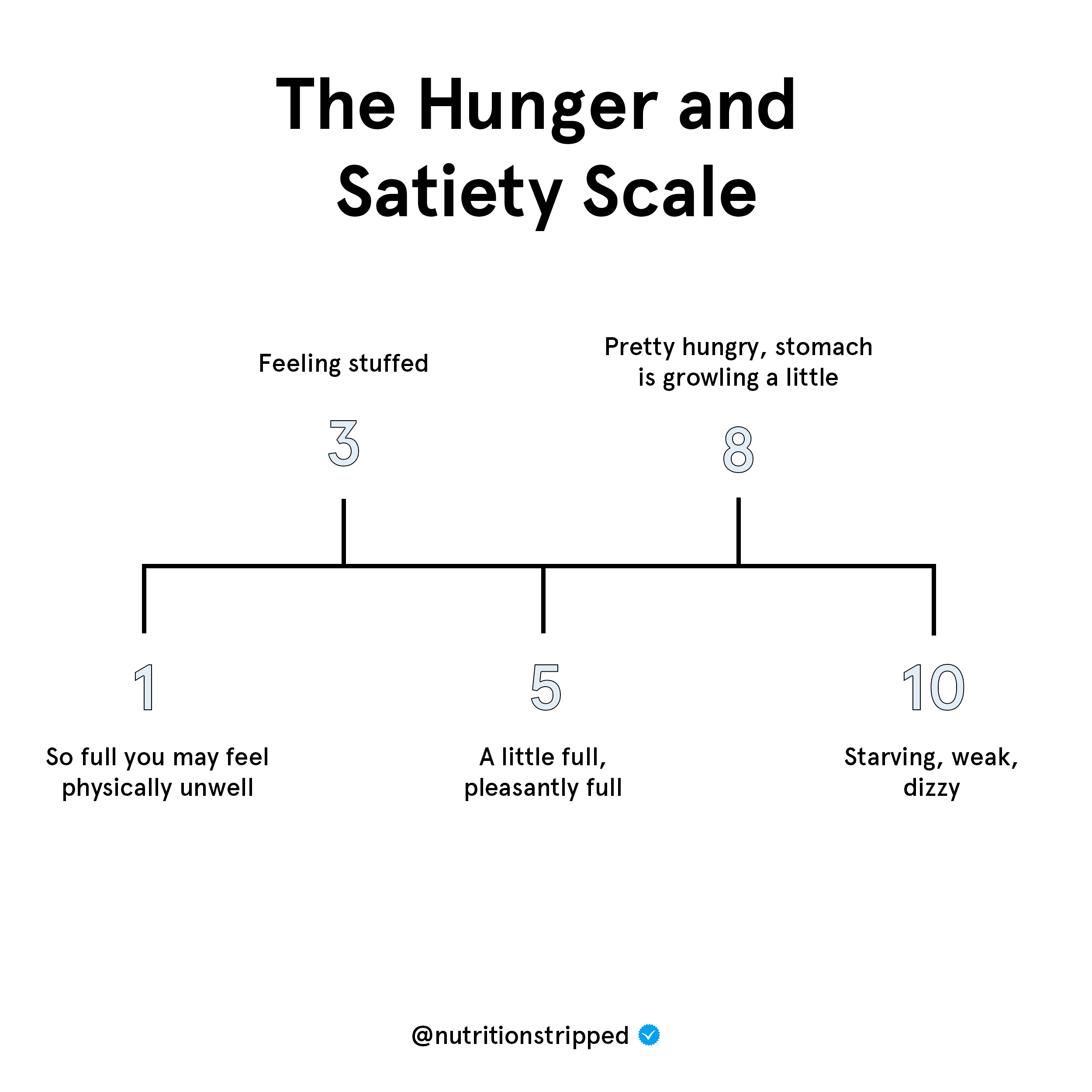Hunger signals are your body’s way of telling you that it needs energy.
Being in tune with your hunger signals and your body’s needs helps you make food choices based on your unique needs as well as understand when things other than hunger are influencing your desire to eat, like your emotions, environment, or situation.
When eating mindfully we use our hunger signals to guide our eating and food choices as much as possible, rather than our emotions, situational or environmental cues. (Although there are some times when it’s absolutely OK to eat when you’re not hungry and we’ll explore that later in this article).
Let’s dive into why hunger cues are so useful for maintaining healthy eating habits.
Why Tuning Into Your Hunger Signals Is Important For Lasting Healthy Eating Habits
Learning to listen to your body and read the signs it’s sending you is just as important as what you eat.
As Registered Dietitians were taught about hunger and fullness scales to teach and support our clients cultivate mind-body awareness to make the best food choices for your unique body.
There are a few important reasons to be in tune with your hunger levels.
1. Your Hunger Signals Tell You What Your Body Needs
Your hunger signals are your body’s way of telling you what it needs to feel and function its best. This may be that it needs more energy (food) or that the portion of food you ate was too much (feeling stuffed).
With mindful eating, we’re really focused on developing a strong mind-body connection. This allows us to understand what works uniquely for our own body and accept that what works for one person may not work for you. This is why so many diets, plans, and trends don’t work — because they are one-size-fits-all solutions and ask us to follow specific guidelines or rules without tuning into our own bodies to see if it’s working for us.
A great example of this is the rise of intermittent fasting. I’ve had so many people message me saying that they’re trying to fast but they’re always so hungry during the fast or by the time they go to break the fast. Rather than listening to their own body, they’re following rules set out by this trend. While there is nothing wrong with trying new things, you have tune into your body to see how it works specifically for you and honors your body’s needs.
While there are many signals our bodies may send us, your hunger cues are ones that are present in your daily life and a great starting place for building a stronger mind-body connection and understanding your unique needs.
2. They Guide Your Portion Sizes
As you become more familiar with your body’s own unique hunger cues, you’ll learn how to make choices that best work from you — especially around what portion sizes you need based on your current hunger levels. The portion sizes you need to change day-to-day and meal-by-meal based on what your body needs and what you have (or have not) eaten.

3. Help You Navigate Emotional Eating
Many times, things outside of our hunger can influence our decision to eat and our food choices. One of the most common things we hear and support our community with is emotional eating or a more specific form of emotional eating — stress eating.
Emotional eating is when your emotions — anything from boredom to stress or grief — are guiding what, when, and how much you eat, rather than your physical hunger signals.
When you are in tune with your hunger signals, you’re better able to identify when you’re truly hungry or when your emotions are causing you to reach for food for comfort.
4. Prevent Eating When Bored
Along similar lines to emotional eating is eating when you’re bored. This is what we call “head hunger.”
When we’re bored, it’s common to mindlessly reach for snacks or sweets. By practicing using your hunger levels, you can identify when you’re doing this and instead choose another activity to fill your time.
5. Hunger Signals Help You Notice Situational or Environmental Triggers
Another reason we tend to eat aside from being physically hungry is that we’re exposed to a certain environmental or situational cue.
An example of an environmental trigger may be seeing cookies or bags of chips at the office in the break room. When you pass by, they’re sitting there for you to grab and you might subconsciously eat them even when you don’t truly want them, simply because they were there.
A situational trigger may be something like going out to eat. When we go out to eat, we choose an item off of the menu that sounds delicious, and then the server brings out the plate to us. The portion on the plate is the same for everyone who orders that entree. So as you’re eating at a restaurant, you may be more inclined to finish your plate, even if you’re only hungry enough for half of what was served.
Checking in with your hunger levels before you eat can help you identify if you’re actually hungry or if the environment or situation you’re in is influencing your decision of what to eat or how much to eat.
Measuring Your Hunger Levels
There are several different types of hunger signals that we teach our clients and members inside of our mindful eating program and wellness coaching, but the easiest to get started with is your hunger levels.
Throughout the day, before meals, during meal times, in between meals, etc., take note of where you are on the hunger and satiety (i.e. fullness) scale.
No matter where you fall on the scale, approach this practice with compassion for yourself. It’s okay if you overate or if you went too long without eating. It happens to us all!
This practice is designed to help you bring awareness to why that might be, how you feel when that happens, and how you may need to adjust. With practice, you’ll be able to better understand what your body wants and needs and make choices that align with what it’s asking for.

Is It Okay to Eat When You’re Not Hungry?
Absolutely! There are plenty of reasons to eat even if you aren’t hungry. This may be enjoying dessert after dinner or eating to give your body nourishment even if something like stress is suppressing your hunger.
With mindful eating, it’s all about having awareness of why you’re eating so you can choose what’s best for you at that moment.
You may say to yourself, “I’m not that hungry, but I would actually enjoy that dessert right now.”
On the other hand, you may say, “I notice that I’m not actually hungry, but I really want a snack. I think it’s because I’m bored right now. What could I do instead?”
Whatever it may look like for you, this awareness can help you make intentional choices.
Start Practicing Using Your Hunger Signals
Now, it’s time for you to put this into practice. At your next meal, stop to check-in with yourself and see where your hunger levels are at. This might be challenging at first, so be patient with yourself as your practice and learn.
You can find more practices for creating mindful eating habits inside of my free guide!
The post Why Hunger Signals Are Important To Understand And Use appeared first on Nutrition Stripped.
from Nutrition Stripped https://ift.tt/3lAzKvg

Post a Comment